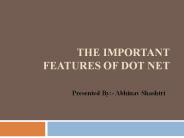Towards Effective Runtime Trace Generation Techniques in the 'NET Framework - PowerPoint PPT Presentation
Title:
Towards Effective Runtime Trace Generation Techniques in the 'NET Framework
Description:
Kriszti n P cza, Mih ly Bicz , Zolt n Porkol b. E tv s Lor nd ... http://avalon.inf.elte.hu/src/netdebug/default.aspx. Trace generation using the profiler ... – PowerPoint PPT presentation
Number of Views:50
Avg rating:3.0/5.0
Title: Towards Effective Runtime Trace Generation Techniques in the 'NET Framework
1
Towards Effective Runtime Trace Generation
Techniques in the .NET Framework
- Krisztián Pócza, Mihály Biczó, Zoltán Porkoláb
- Eötvös Loránd University, Budapest
- Faculty of Informatics
- Department of Programming Languages and Compilers
2
The structure of this presentation
- Motivation, problem statement
- Tools .NET Debugging and Profiling
Infrastructure - Trace generation using the debugger
- Trace generation using the profiler
- Comparing the methods
- Future work
3
Motivation, problem statement
- Usage in industry
- Generate runtime trace during execution
- Real-world applications in production environment
- Non-intrusive
- No development environment allowed
- No debugging capabilities (no side effects)
- No human interaction
- Error detection
- Usage in academy
- Generate trace for program slicing
- Identify statements that affect a variable at a
given program location
4
.NET Debugging and Profiling Infrastructure
- Design time interface
- Debugging events
- Different process
- Notifications
- Symbol manager
- Interprets PDB files
- Identification of program elements
5
.NET Debugging and Profiling Infrastructure
- Publisher
- Enumerates runningmanaged processesin the
system - Profiler
- Events
- Resource usage, CLR events (JIT, Load, GC, memory
allocation, exceptions, etc.)
6
Trace generation using the debugger
- Based on MDbg (corapi2, corapi)
- Steps
- Create process under the control of the debugger
- Set a breakpoint at the program entry point
- Start the application
- After reaching the breakpoint do Step-in
operations
7
Trace generation using the debugger
- What a debugging event (Step-in, breakpoint
reached) does - Sets evtComplete AutoResetEvent
- Waits for evtModState AutoResetEvent
- What the main program does in a while loop
- Waits for evtComplete AutoResetEvent
- Generates trace about the current sequence point
- Sets evtModState AutoResetEvent
- Download
- http//avalon.inf.elte.hu/src/netdebug/default.asp
x
8
Trace generation using the profiler
- Technical background
- In-process
- Implement a COM interface in C to handle
profiler events - Environment variables must be set
- The assembly metadata should be extended when
loaded - Reference for methods generating trace - Tokens
- ModuleLoadFinished profiler event
- Requires IL Code Rewriting
9
Trace generation using the profiler
- ClassLoadFinished
- Profiler event
- Visit all methods of theclass and rewrite
- Method types
- Tiny
- Fat
- IL Instruction types
- No parameter, one integer parameter, token
parameter, multiple parameters - Exception Handling Clauses (EHC)
- Try, catch, finally
10
Trace generation using the profiler
- Code Rewriting steps
- Query IL Code binary data
- Break it at sequence points
- Parse binary data and store it in custom data
structures (binary representation of every IL
instruction) - Upgrade method and instruction format ()
- Insert instrumentation code at every sequence
point() - Recalculate offsets and lengths ()
- Store the new representation in binary format
11
Trace generation using the profiler
- Upgrade method and instruction format
- Problems while inserting new IL instructions
- Can break the limitations of tiny methods
- Short branch instructions maximum relative
length can be too short - EHCs representation of offset and length
limitation can be too restrictive - Solution
- Upgrade method format
- Convert short branch instructions to long branch
instructions - Store EHCs offset and length in DWORD instead of
BYTE or WORD
12
Trace generation using the profiler
- Insert instrumentation code at every SP
- Template
- Substitute
- 1-4 bytes, 6-9, etc. bytes with current line and
column numbers
BYTE insertFuncInst31 insertFuncInst0
0x20 //ldc.i4, start line insertFuncInst5
0x20 //ldc.i4, start column insertFuncInst10
0x20 //ldc.i4, end line insertFuncInst15
0x20 //ldc.i4, end column insertFuncInst20
0x20 // ldc.i4, func. id insertFuncInst25
0x0 // ldc.i4.1 or ldc.i4.2 insertFuncInst26
0x28 // call ((DWORD )(insertFuncInst27))
tracerDoFuncMethodTokenID
13
Trace generation using the profiler
- Recalculate offsets and lengths
- Recalculate method length
- Recalculate branch relative offsets
- Point to the first instruction of the new
sequence point if pointed to the first
instruction of the old one - Point to the same instruction of the new sequence
point if pointed to the not first instruction of
the old one - Recalculate EHCs offset and length
14
Comparing the methods
- None of them require us to modify the original
source code - Differences
15
Comparing the methods
- Test results
- Advance with the Profiler
16
Future work
- Variables of different types
- Almost finished
- Exception handling
- Anonymous methods
- Generic types
- Application domains
- Integrate with program slicing
17
Demo
18
- QA
Krisztián Pócza kpocza_at_kpocza.net
Mihály Biczó mihaly.biczo_at_axelero.hu
Zoltán Porkoláb gsd_at_elte.hu































